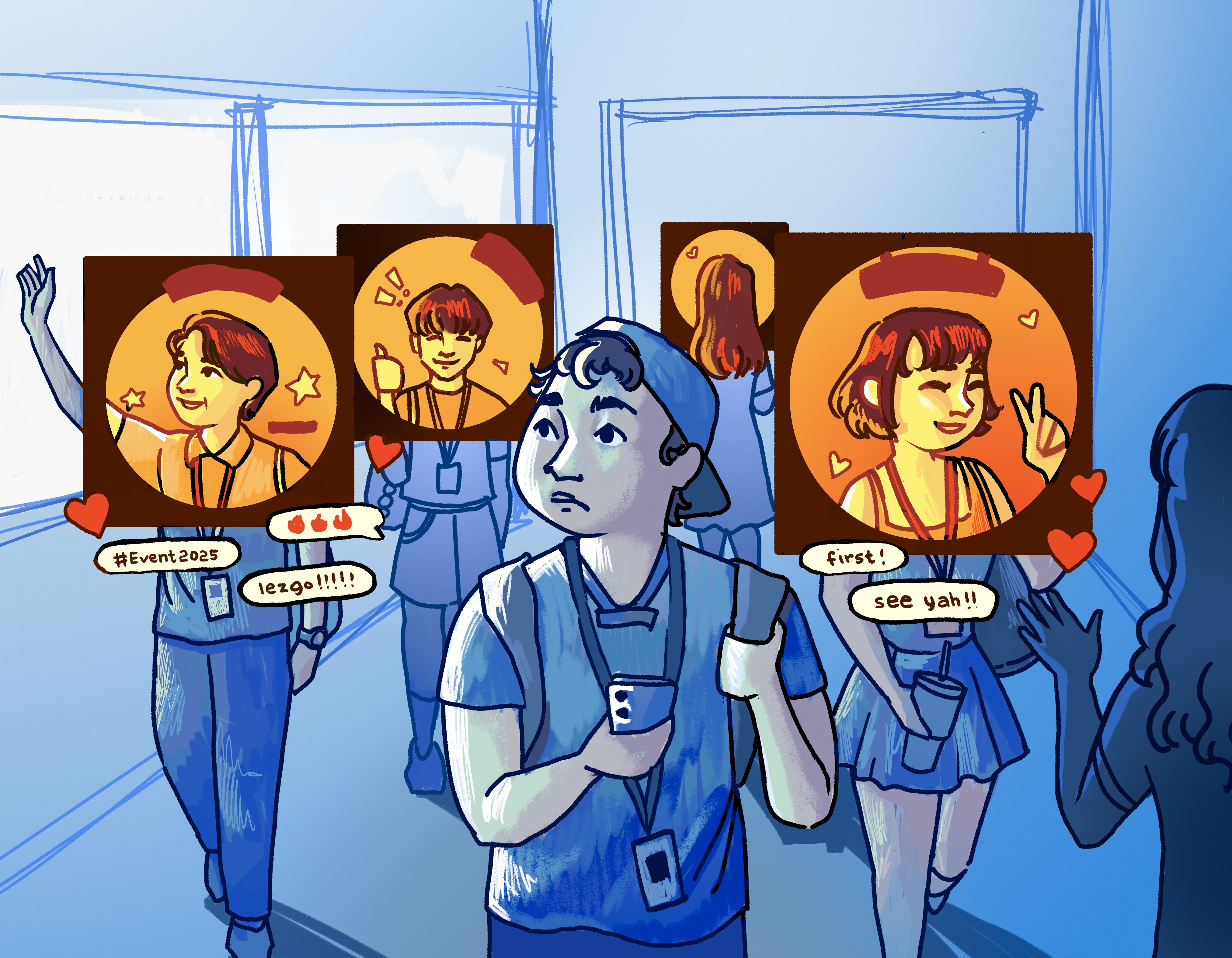Posters for university events plaster the bulletin boards. Classmates chatter and stress over the next org activity. Laughter spills from org tambayans, filling every corner of the hallway. Surrounded by voices full of excitement, some students stand firm in their choice to stay out of it all.
The org culture in UP Diliman is undoubtedly alive in many students’ hearts, but for others, it is more of a distant noise, something observed rather than lived. For them, the sense of belonging that orgs offer does not quite resonate. As ideas of community and connection evolve, more students are beginning to question whether organizations are still the best — or only — spaces for meaningful participation on campus.
Student engagement is now taking new forms beyond the bounds of organizations. As students rethink what it means to take part in campus life, we are also prompted to reconsider how we define community, contribution, and purpose within the university — and whether being in an org is truly essential to surviving UP.
Where to Belong
Student organizations have historically been closely tied to movements both within and beyond the campus. They have long engaged in political struggles, with a surge of organizing in 1969 and 1971 alongside the national democratic movement, forming groups allied with Kabataang Makabayan (KM) and Samahang Demokratiko ng Kabataan (SDK). They mobilized protests, advocated causes, and fueled the student movement, much like how various organizations today unite to oppose campus commercialization.
But even with the historical importance of organizations to campus engagement, many students remain orgless. For some, this is not due to a lack of interest, but because of heavy demands within the org system. For them, the deciding factor isn’t the workload but the rigorous application process and kupal culture — an evolution of hazing characterized by power-tripping and toxic behaviors that create barriers to entry. While some endure this toxic culture due to social pressure and the perception that traditions within organizations are rigid, others choose to steer clear of it.
As the university’s org culture evolved, reviving the org environment at UP proved challenging during the post-pandemic transition. This was further complicated by shifts in the student demographic, such as private school qualifiers outnumbering public school students over three years of UP College Admissions, which may indicate more affluent students being admitted than before.
Recently, groups openly linked to wealth and privilege have noticeably increased, with participation often dependent on one’s privilege. Many on social media now share tips on how to avoid organizations perceived to cater mainly to the affluent. It does not help when some of them become embroiled in controversy, such as having questionable application processes, extravagant parties requiring large sums of money, or a culture that prioritizes image over inclusivity.
Whether these perceptions are accurate or not, they highlight social and economic divides, raising concerns about elite groups being exclusionary, isolating themselves, and excluding lower-income students, according to a University of Pennsylvania study. Such dynamics only solidify what most students experience: Driven by a need to belong and fear of exclusion, participation now often comes from obligation rather than choice.
Orgless but Surviving
As orgless students navigate college life without the structure of an organization, they often take alternative routes to involvement. They either engage differently with the community, such as volunteering outside the university, or focus on different priorities, such as personal responsibilities and academics.
While some orgless students embrace the freedom that comes without formal commitments, the absence of a community can also bring feelings of isolation. Since college events like Engg week are largely centered around organizations, some students feel isolated and disengaged because they do not belong to an org that they connect with, deepening their disconnection from the community.
While some orgless students feel isolated or disengaged, others manage to stay well-informed and involved in college or university life through classes, social media, peer interactions, or personal experiences. Still, awareness and engagement levels vary, and without the regular exposure that orgs provide, many miss out on the institutional memory, student-led initiatives, and broader discourse shaping student life.
Belonging, Reimagined
While student organizations have historically played a vital role in shaping university life and activism, they aren’t accessible or appealing to everyone. Given the fragmented efforts of orgless students, fostering a more inclusive campus requires intentional engagement with them and hearing their concerns.
Still, for orgless students, there must come a recognition that they do not exist in a vacuum. They are part of a community all affected by common issues such as dorm shortages, academic ease, and creeping commercialization. Fragmented efforts to challenge these threats, no matter how sincere, often fall short without coordination and unity among students. As community members, collective action is essential — even if such action does not come from an official student organization.
To truly support orgless students — especially in a system that often treats org membership as the sole path to meaningful involvement — organizations need to reflect and evolve. When the core values of awareness-raising and inclusivity take precedence over outdated, exclusionary practices, student orgs can become more welcoming spaces. In doing so, they open the door for orgless students to engage more actively and help shape a university culture that embraces everyone.
But beyond formal organizations, the campus is alive with many other forms of collective student life that also shape the university experience. UP dorm groups, blocks, volunteer groups, informal networks, campus pubs, and even casual friend circles all contribute to the campus community. The council plays a key role in recognizing and supporting these diverse forms of student engagement alongside traditional organizations.
It is high time for student leaders, orgs, and councils to recognize that orgless students exist and that there are reasons behind their choice. Including them in events, acknowledging their potential contributions, and making conscious efforts to reach them can help turn fragmented efforts into organized, impactful action.
The increasing number of orgless students doesn’t necessarily signal apathy, but highlights ongoing systemic gaps, barriers, and unmet needs. Listening to their voices invites us to reconsider not just what belonging means, but how student involvement is understood. If the university truly values the diverse concerns and needs of its students, then engagement will not only grow in number — it will also deepen in purpose and impact. ●
First published in the May 27, 2025, print edition of the Collegian.







